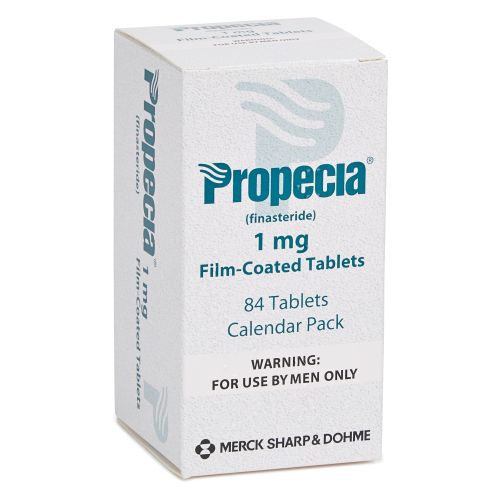
Description
Finasteride (Propecia) is used for the treatment of male pattern hair loss. This medicine is for use in men only.
What is Finasteride?
Finasteride is a drug used to treat male pattern hair loss, a common condition that involves hair thinning on the scalp that often leads to a receding hair line or balding on the crown of your head. It affects some men from 20 years old and is more common as men age, affecting the majority of males at some stage throughout their life.
Finasteride is the generic name of the drug and is the active ingredient in the medication that works to reduce hair loss.
What is the difference between Finasteride and Propecia
Finasteride is the active ingredient in Propecia and is available in a generic, unbranded tablet. Finasteride and Propecia are medically equivalent but Finasteride is available at a much lower cost.
Generic medicines contain the same active ingredient and are equally effective and medically equivalent as the branded products but are available at a lower price. Generic manufacturers have to demonstrate that they are medically identical to the branded product - i.e. they offer the same quality, strength, stability and effectiveness.
What is alopecia?
Alopecia is another name that refers to male pattern hair loss. Normally, one hair grows from each hair follicle for about three years. After this time, it is shed and is closely followed by a new hair growing from the same follicle.
For men with male pattern hair loss, the hair follicles become smaller over time and each hair is thinner and falls out sooner than previously. Eventually, this can lead to hair follicles so small that the hair does not reach the skin surface.
The main cause behind this change in the hair follicles is an androgenic hormone called dihydrotestosterone. It is for this reason that this hormone is the target for drugs to treat alopecia.
When the hair has been gone for extended periods of time, the hair may become permanently lost hence timely treatment is beneficial.
How does Finasteride work?
The active component if Finasteride, works to inhibit an enzyme in the body called 5-alpha-reductase. This enzyme usually converts testosterone into dihydrotestosterone, the more potent androgen that has a negative effect on hair growth.
As a result of using Finasteride, the levels of the dihydrotestosterone hormone are lower and a positive effect can be seen on the maintenance of hair and hair growth of men who suffer from male pattern hair loss.
How long does it take to see results?
With regular Finasteride treatment you may begin to see the results within a few months, although it could take up to a year to notice the full benefit. It is important that you continue treatment long enough to see the results on male pattern hair loss, as the improvement won't occur overnight.
If you haven't noticed a benefit after using Finasteride regularly for one year or more, further treatment is likely to benefit and it is recommended to stop use.
If you decide to stop treatment with Finasteride, you will likely lose any hair growth gained in the previous 12 months of treatment. It is recommended to discuss your options and the best solution for you with your doctor.
How do you take Finasteride?
Timely treatment is crucial to avoid losing as much hair as possible and you should therefore talk to you doctor about treatment options as soon as you begin to notice signs.
You should take Finasteride at the same time every day with a full glass of water. It is important that you take it regularly to see the long-term benefits, so it is a good idea to incorporate it into your daily routine. You can take it with or without food, as desired.
It is best to take it exactly as prescribed. You should talk to you doctor before taking larger doses of for a longer period than recommended.
Is Finasteride Effective?
This is the question everyone wants to know and fortunately the answer is positive, according to the clinical research data we have available.
One 2-year study followed 535 men taking Finasteride. Of these, 99% experienced visible results (66% with hair growth, 33% no additional hair loss), according to a photographic assessment by dermatologists
Another study followed 279 men for 5 years of treatment with Finasteride and found that 99% had visible results (48% with hair growth and 42% no additional hair loss), according to the same dermatologist photographic assessment.
It was found that Finasteride is more effective to cause hair regrowth on the crown of the head (the vertex), but there is little evidence to the receding frontal hairline.
It is worth noting that neither of these studies compared the treatment directly to placebo, as the results were examined independently. However, this could improve the quality of the clinical research supporting the use of Finasteride.
Does Finasteride have side effects?
All medicines have the potential to cause side effects on the body, although not everybody experiences them.
Some common side effects for Finasteride include:
- Erectile Dysfunction
- Decreased Sex Drive
If you decide to continue using Finasteride, these side effects may lessen after some time. If the symptoms are inhibiting and do not resolve, you can consider stopping the medication with your doctor.
Some people can also have allergic to this medication and the following symptoms are indicative of this:
- Skin rash and itching
- Swelling of lips, face, tongue or throat
- Difficulty breathing or swallowing.
If you experience these signs it is essential that you stop taking the medication and see your doctor immediately.
Patient Information Leaflet
Always read the patient information leaflet before commencing treatment. Patient information can be found here.
Alternatives
Regaine (Minoxidil)
A topical hair loss lotion that needs to be applied twice a day. 52% effective in clinical trials compared to 90% for Finasteride.
